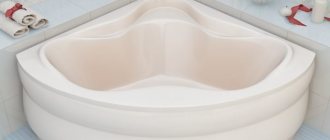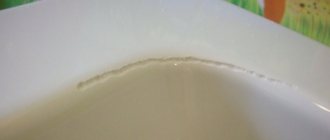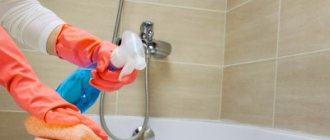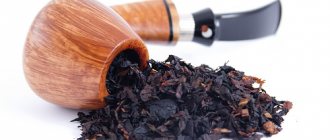It is human nature to become attached to everything that is established: habits, things, a car and... a bath. Don't be surprised - a good old cast iron bathtub. However, the new is slowly but steadily making its way. So, and with fonts, where the tension from the bustle of the city is relieved. Acrylic is replacing cast iron.
And here an unpleasant surprise awaits many. No one changed the water or the plumbing. But it is either hard, and then limescale deposits on the walls, or with iron - unpleasant rusty stains appear on the bottom, or even with chlorine - instead of shining whiteness, a dull yellow color appears. Attempts to correct the situation using the usual methods make it even worse - the inner surface of the bowl becomes dull, covered in scratches, and in some cases completely destroyed.
This happens because the owners do not know the basic rules for using acrylic bathtubs and how to care for them. Therefore, the editors of the StroyGuru website have set themselves the task of giving practical advice to their visitors on how to clean an acrylic bathtub at home. Types of equipment and cleaning products, folk methods of combating pollution, methods for restoring mechanical damage to the acrylic layer, and the nuances of operation will be considered.
Everything from A to Z about the properties of an acrylic bathtub surface
Acrylic is a multicomponent polymer material obtained as a result of the synthesis of acrylic, methacrylic acids and fillers, soluble in water. To harden the acrylic, a hardener is added. After drying, acrylic is guaranteed to acquire a stable color and a reliable, durable coating for many years, which requires systematic and proper care. An acrylic bathtub is a plastic bathtub with a layer of acrylic applied to the inner surface. There are acrylic bathtubs with and without a reinforced layer, but the care for all types of acrylic bathtubs is the same.
How to care for an acrylic bathtub at home and what to clean it with? To answer this question, let's first get acquainted with the properties of acrylic bathtub coating, since these pros and cons directly affect recommendations for the proper use and care of such bathtubs.
Properties of acrylic bathtub surface
First, let's consider all the advantages and advantages of acrylic bathtubs: • a snow-white glossy acrylic surface, which has a very neat, aesthetic and attractive appearance, leaves no one indifferent, as they say - pleasing to the eye; • low thermal conductivity coefficient allows you to maintain the temperature of the collected hot water for a long time. In such bathtubs, the water remains warm much longer than in cast iron and steel bathtubs; • increased antibacterial properties of the acrylic coating due to the absence of micropores in the surface, which prevents various bacteria and microorganisms from collecting on the surface of the bathtub. Moreover, this is important at constant high humidity and temperature in bathrooms, where the most favorable conditions usually exist for the emergence and spread of various kinds of bacteria and microorganisms; • during the operation of the bathtub, chips often appear on its surface from impacts of various heavy objects. If the impact damages the enamel that covers steel and cast iron bathtubs, then a source of corrosion will inevitably subsequently arise in this place. This does not affect the surface of acrylic bathtubs, which is also one of the advantages of acrylic bathtubs. Plastic baths never corrode; • plastic bathtubs, on which a layer of acrylic is applied, are lightweight. This is a big advantage during transportation, lifting and installation compared to cast iron bathtubs; • acrylic bathtubs come in a variety of shapes, designs and sizes. A large selection of models of such plumbing products is also one of the advantages when a buyer chooses between an acrylic and a cast iron or steel bathtub; • the acrylic surface of the bathtub is very easy to clean from dirt at home. Cleaning products are produced by many manufacturers and are very affordable for almost any consumer. Along with so many advantages of acrylic bathtubs, there are also disadvantages of acrylic surfaces. All the disadvantages and disadvantages of acrylic bathtubs: • low resistance to high temperatures. Acrylic cannot withstand and begins to melt at temperatures of 100 degrees Celsius and above. Naturally, almost no one allows water with a temperature close to 100 degrees Celsius to enter the bathtub, but very hot water, combined with great mechanical stress from the large weight of the collected water, sometimes leads to deformation of the surface. This primarily applies to inexpensive bathtub models that are made from cheap and thin plastic; • although acrylic bathtubs have a certain hardness and strength, do not forget that they are still plastic. The highest quality and most expensive plastic will serve you for a maximum of 10 years, after which it begins to lose its properties. In addition, it should be noted that cheap samples of acrylic bathtubs are made of thin plastic, the strength of which is far from that of their expensive counterparts. Sometimes this leads to the fact that the weak plastic bottom simply cannot withstand the loads of the accumulated water and the weight of the human body. As a result, the acrylic bathtub cracks, and in most cases cracks through, which can lead to flooding of the neighbors on the floor below; • at the same time, the surface of an acrylic bathtub is easy to scratch, and with a strong impact, it can be pierced through; • possible yellowing of the acrylic surface of the bathtub after a certain period of time. Yellowness does not always occur. If low-quality materials were used in the production of an acrylic bathtub, in particular a hardener, then the appearance of yellowness after a certain period of time is inevitable. Yellowness also appears due to exposure to chlorine, which is present in certain quantities in tap water; • low resistance of acrylic coating to household chemicals. When caring for an acrylic bathtub at home, you should not use any detergents or cleaning products. In simple words, acrylic bathtubs cannot be washed with anything. Acrylic is afraid of household chemicals containing: • chlorine and all its varieties - the surface under the influence of chlorine loses its shine, turns yellow and slowly deteriorates due to the formation of pores, which reduce the life of the product; • acetone and other solvents corrode plastic, resulting in cloudiness and dents; • ammonia, as well as most bleaches that contain it, destroys the molecular structure of acrylic; • all formaldehydes are incompatible with all types of acrylates in their composition; • under the influence of alcohols, alkalis and acids, acrylic melts. In order for your new shiny acrylic bathtub to serve for a long time and delight the eye with its radiant appearance, it is necessary to take into account all the above features of the properties of acrylic bathtub surfaces.
The best professional bath cleaning products
Products in this category contain a high concentration of active ingredients. They are intended for professional use, but can also be used at home. They are most often produced in concentrate format. They are able to cope with the most difficult cases, for example, removing dirt after renovation or cleaning old plumbing.
4 Pro-Brite Silan concentrate against limescale and rust
The fourth place goes to Pro-Brite Silan concentrate against lime deposits and rust.
Pro-Brite is one of the leading companies on the Russian market producing professional chemicals for household and industrial environments. All brand products are made from high quality raw materials. Silan concentrate is a highly acidic, low-foaming agent. The product is liquid, colorless, with a sharp, specific odor.
The composition is effective against rust, scale, fossilized lime deposits, various oxides on stainless steel products, ceramics, porcelain and other acid-resistant surfaces.
The product is suitable for removing mineral deposits from washing machines and dishwashers and for cleaning plumbing fixtures. The concentrate is non-corrosive.
The product is intended for use in food production and catering organizations, laundries, as well as in everyday life. When using, you must strictly observe all precautions and work with the substance in gloves, a mask and a protective suit.
Pros:
- Highly effective composition.
- Suitable for cleaning sanitary ware, washing machines and dishwashers.
- Effectively removes rust, limestone, scale.
- Does not cause corrosion.
- Economical consumption.
Minuses:
- Acrid smell.
- Difficult to find on sale.
Pro-Brite Silan concentrate against lime deposits and rust
3 Pro-Brite for delicate cleaning Asin
Third place is occupied by another product from the manufacturer of professional chemicals Pro-Brite - a spray for delicate cleaning of plumbing fixtures Asin.
The product comes in a black plastic bottle with a spray nozzle. There are also 5 liter canisters with a flow dispenser on sale.
Compared to its predecessor, this product is softer in composition and more versatile. It is suitable for cleaning delicate surfaces, including acrylic, enamel, chrome, aluminum, nickel and many others.
The liquid is a ready-made acid solution. After application, it is necessary to keep the composition on the treated area for several minutes, then wipe with a sponge and rinse. The formula instantly dissolves soap scum, protein stains, lime deposits and traces of rust. The product returns shine to products and forms a protective film that prevents the deposition of various contaminants. It also copes well with unpleasant odors. At the same time, it itself has a neutral aroma, not caustic or irritating.
Pros:
- Suitable for cleaning delicate items, including acrylic.
- Effectively removes lime deposits, soap deposits, and traces of rust.
- Gives shine.
- Forms a protective layer.
- Destroys unpleasant odors.
Minuses:
- Difficult to find on sale.
Pro-Brite spray for delicate cleaning of plumbing fixtures Asin
2 Cif Professional
On the second line is Cif universal cream Professional.
The product is produced in a plastic canister with a volume of 2 liters. The product has a thick creamy consistency and is easily applied to the treated area. The composition includes microcrystals that provide more thorough and deep cleansing without damaging or scratching the surface. And the cream format prevents the possibility of inhaling particles of the product and ensures economical consumption.
The cream is suitable for cleaning plumbing fixtures, tiles, stoves and ovens. It does not damage the surface of laminated, plastic, chrome and metal products. The product effectively removes not only lime and soap deposits and traces of grease, but is also able to dissolve old and difficult to remove stains from the tile surface.
Buyers are satisfied with the quality of the product, noting its high efficiency against various contaminants and good washability. The advantages also include versatility and a fairly pleasant, mild aroma.
Pros:
- Effectively removes lime deposits, soap scum, and grease.
- Dissolves old stains.
- Suitable for cleaning surfaces in the kitchen and bathroom.
- Gives shine.
- Easy to apply and easy to wash off.
Cif universal cream Professional
1 Grohe GROHclean Professional
The deserved leader in the category of professional products has become the GROHclean Professional spray from the German brand Grohe.
The spray is available in several formats and volumes, but the most convenient is an ergonomically shaped plastic bottle with a spray nozzle. Its volume is 500 ml. To save money, you can buy 5 liter canisters.
The product is universal. It quickly removes lime deposits, soap scum, various stains, dirt and grease. The product is suitable for cleaning bathrooms and kitchens, showers, plumbing fixtures and tiles.
The spray is very easy to use. For a high-quality result, it is enough to spray the substance onto the surface to be cleaned, leave it for a short time and rinse with hot water. No additional actions are required, the dirt is completely left behind and washed off. When used, there is a specific smell, but it is not sharp or caustic.
The manufacturer also took care of nature. The composition is environmentally friendly. The main active component is citric acid, and the surfactants included in the formula are 90% biodegradable.
Pros:
- Convenient spray format.
- Effectively removes lime deposits, soap scum, and grease.
- Dissolves old stains.
- Suitable for cleaning surfaces in the kitchen and bathroom.
- Easy to use (just apply and wash off after a while).
- Safe for the environment.
Minuses:
- Price.
Grohe spray GROHclean Professional
Proven equipment for caring for an acrylic bathtub
To clean the surface of the bathtub, use soft ordinary sponges, soft rags with lint, such as flannel and microfiber, and fabric napkins. It is strictly forbidden to use any sponges that have an abrasive coating, which can scratch the acrylic coating. Do not use hard brushes, scrapers, sponges or scourers.
The acrylic coating scratches easily. We do not recommend storing metal or sharp objects on the shelves above the bathtub. If such objects are accidentally dropped, chips and scratches may occur.
Secrets of experiments: folk remedies - benefit or harm?
Here we provide a list of folk remedies that can be used correctly to wash away certain types of stains. However, we do not recommend their constant use for cleaning acrylic bathtubs at home, if only because none of them restores the acrylic shine of the bathtub coating.
Baby soap
We do not recommend constantly using baby soap, although it is made from ingredients that are safe for the health of the child.
Using baby soap, you can wash fresh, small stains just once, but not all of them. Therefore, baby soap is unsuitable for the permanent care of acrylic bathtubs.
Laundry soap
During the collapse of the former USSR at the end of the last century and the total shortage, laundry soap as a means for cleaning bathtubs became very widespread.
Firstly, laundry soap, due to its low cost, was widely available. Secondly, laundry soap was always produced in sufficient quantities and was never a scarce product. Thirdly, laundry soap was absolutely safe in its chemical composition.
If anyone remembers, in those days infants were bathed with laundry soap. In those days, the use of laundry soap was entirely justified. But times change, and laundry soap is no exception. GOST standards have been changed several times over the course of several decades. Accordingly, the chemical composition of laundry soap has changed a lot, and not for the better.
As they say, now “the entire periodic table” is in laundry soap. Therefore, now it should not be used as a detergent for cleaning acrylic bathtubs, and at maximum, you can simply damage the acrylic coating with the aggressive components included in its composition.
This is not only a theory, there are also not isolated cases in practice when a new acrylic bathtub was constantly washed with laundry soap. The result is that after 6 months the bathtub lost its appearance and turned yellow. Many websites advise using laundry soap at home.
Should I use it or not? It's up to you to decide, but we strongly recommend not to do this. If “finances generally sing romances,” it’s better to buy an inexpensive “Cinderella” cream for acrylic baths. When cleaned with Cinderella, the surface of the bathtub is guaranteed not to be damaged.
Liquid soap
On many sites you can also find advice on using liquid soap, various gels, and so on. It's up to you to decide whether to use them or not. We definitely do not recommend doing this. Moreover, all these funds do not fall on you from heaven, and also have their own price, in any case no less than the cost of “Cinderella”.
Table vinegar
Vinegar is very good at removing limescale, but, on the other hand, it can also damage the surface of your bathtub. Therefore, we also do not recommend its use.
Hydrogen peroxide
To enhance the cleaning effect, some experts recommend using table vinegar and adding hydrogen peroxide to it. Proportion: 3 parts table vinegar and 1 part hydrogen peroxide. We do not recommend doing this.
Citric acid solution
With the help of citric acid, you can cope with surface contamination of bathtubs such as rust and limescale. A solution of lemon juice is good at corroding fat deposits. This remedy is perhaps the only folk remedy that can be safely recommended for use.
Cleaning with citric acid does not take up your time. The recipe is very simple: • fill the bath with warm water; • dissolve citric acid (50 g) in a small amount of warm water; • pour the prepared solution into the bath; • mix the water well and leave to brew for 10-12 hours; • drain the water, wash the bathtub with warm water and wipe with a dry cloth.
Baking soda or Pemolux
Grandma's proven cleaning product. Sodium is able to perfectly break down fats and other organic compounds. However, there is a high chance that some sodium crystals may not dissolve in the prepared mixture and you will simply scratch your acrylic bathtub. This is at a minimum, at a maximum - soda will eat up all the gloss and the surface of your bathtub will remain matte forever.
Some people advise diluting baking soda with plenty of water. But the effect of such dilution, you will agree, will be appropriate. Therefore, we do not recommend using baking soda as a cleaner for acrylic bathtubs.
Toothpaste
Toothpaste is the best solution for cleaning acrylic bathtubs. Although this remedy is more related to household chemicals, and not to folk remedies. In any case, the effectiveness of a given cleaning product comes up against the cost of care. Therefore, using toothpaste to clean the entire surface of an acrylic bathtub is very expensive and impractical.
But in some cases, toothpaste is still used to clean a certain area of the bathtub surface that has, for example, gotten hair dye or other dyes. Rub toothpaste onto the damaged area using a rag or sponge. Wait a few minutes. Rinse off the toothpaste with warm water and wipe the area with a dry cloth.
However, there are toothpastes that contain abrasive inclusions. The hard particles of such pastes can scratch the surface of your bathtub. Therefore, check toothpastes for abrasive particles before use.
Special means
Industrial products for acrylic are presented in the form of liquid sprays, creams or gels.
Compositions suitable for acrylic can be found among consumer household chemical products and from manufacturers of branded sanitary ware. Professional products can not only remove stains and old plaque, but also return the bathroom to its original color.
Industrial products active against plaque and dirt of various origins:
- Maline (manufacturer: Pro-brite) is a low-concentration acid-based product designed to remove lime and soap deposits on any surface;
- Cif Ultra White (Unilever) – soft cleaning cream against limescale and organic dirt;
- Gel Gloss (Grass) – created on the basis of citric acid, effective against limescale, rust and soap residues;
- Tim-Profi (Bas) is a professional solution for disinfecting and cleaning acrylic bathtubs from the most severe contaminants;
- Meine liebe is a biodegradable eco-product based on fruit acids to remove limescale;
- Sanelit (Stork) – oxygen antibacterial gel against plaque and rust;
Detergents for acrylic bathtubs. - Unicum (Bami) – antibacterial spray for cleaning Jacuzzis and removing rust and plaque on acrylic products, creates a protective coating;
- Mr. Chister (Nevskaya Cosmetics) - an antibacterial agent against limescale, rust, soap stains, forms a protective layer on the surface;
- Cinderella (Ams Media) – emulsion-cream against persistent plaque and old rust, creates a protective coating due to the silicone content;
- Acrilan (Bagi) - a spray for quickly removing old plaque and rust, creates a protective coating for up to 1 week.
Note: It is advisable to test any new product on a small area before use.
You need to know what not to do when caring for an acrylic bathtub?
To ensure that the surface of your acrylic bathtub always remains shining and shiny, we strictly prohibit doing the following:
• soak laundry. With prolonged exposure of the acrylic coating to an aqueous solution of washing powder, the surface of the bathtub will quickly lose its snow-white and glossy appearance; • dye your hair, dye pigments may be absorbed into the surface of the bath; • use products containing in their chemical composition alcohol-containing solvents, bleach, chlorine, acetone, oxalic acid, such cleaning products as “Comet”, “Biolan”, “Sanox”, “Domestos”, “Pemolux” and others. These products are intended for the care of ordinary baths. They can not only make the glossy surface matte, but also deform the acrylic coating itself; • for cleaning, you cannot use all types of hard brushes, sponges and scrapers with abrasive applied; • if you have pets bathing in an acrylic bathtub, place rubber mats on the bottom, otherwise pets with their claws can cause scratches of varying depths on the surface of the bathtub; • we do not recommend washing dishes in an acrylic bathtub; • it is unacceptable to wash bicycles and various spare parts in an acrylic bath; • since acrylic begins to melt at a temperature of 100 degrees Celsius and above, therefore, boiling water from a kettle cannot be poured onto the surface of an acrylic bathtub. Usually in the summer the hot water supply is turned off for 2 weeks. The bath becomes icy, and it is unpleasant to take water procedures in it. Some people pour boiling water over the surface of the bath, some heat it with hair dryers. Sometimes ice is thrown into the bathtub from the freezer compartment of the refrigerator and a kettle of boiling water is poured on top so that the ice quickly melts. Doing this can damage the surface of your acrylic bathtub.
Unicum
A good and inexpensive cleaner designed for old plaque. “Unicum” is a good answer to the question of how to wash yellow stains, thick limescale crusts or mold.
It works immediately after application and after just a minute it can be washed off with a powerful stream of water. It is necessary to work with it wearing glasses and a respirator. The pungent odor causes severe burning of the mucous membranes. It is easy to get chemical burns on your hands, so gloves are also necessary.
By the way, Unicum is also sold in economy packs of 0.75 and 3 liters.
Is it still necessary to disinfect the bathtub and how?
Daily care of an acrylic bathtub - rinse with warm water and wipe dry with a clean cloth. Clean with detergent once a week. At the same time, a fatty coating forms on the walls of the bathtub within a week, which is an excellent breeding ground for fungus and other harmful bacteria.
The fungus reproduces well on silicone sealant, which is used to seal the joints of the walls of the bathroom and bathtub. If you regularly wash your bathtub every week with cleaning products, then there is no additional need to disinfect your acrylic bathtub.
But if you forget or you don’t have time to clean the bathtub once a week with detergents, then it is advisable that you do a complete disinfection of the acrylic bathtub.
If you bathe a small child under 1 year of age in the bathtub, disinfect the bathtub at least once a week. After completing disinfection, wash the bathtub walls with baby soap.
There are several ways in which you can completely disinfect an acrylic bathtub:
• 1st method: treatment with special disinfectants Acrilan, Acrilight, or Santekh. When purchasing, pay attention - the packaging must contain a warning about the absence of chlorine. If there is no such inscription and it is not known whether the product is suitable, then conduct a small experiment - apply a small amount of disinfectant to a small area of the bath and wait 10-15 minutes. If no changes occur in the treated area, then you can treat the entire surface: • first rinse the bathtub with warm water, • then apply a disinfectant to a soft sponge and wipe the entire surface with it, • wait 1-2 minutes and rinse off the applied product with hot water, • Wipe the entire surface of the bathtub dry with a clean cloth.
• 2nd method: treatment with “Belizna”: • fill the entire bath bowl with warm water, • pour two 1 liter bottles of 7% “Belizna” into the bath, • wait 10-15 minutes and pour the solution into the drain hole, • Fill the entire bathtub bowl again with warm water, • wipe the entire bathtub with a sponge, • pour the water into the drain hole, • rinse the bathtub with warm water, • wipe the entire surface of the bathtub dry with a clean cloth.
• 3rd method: treatment with a steam cleaner or steam generator. Hot steam perfectly kills any germs and bacteria, and also removes contaminants. Acrylic melts at temperatures of 100 degrees Celsius and above. Therefore, in order not to melt the acrylic coating of the bathtub, treat with a steam generator with great care, without holding the steam stream in one place.
Domestos without chlorine
Chlorine-free Domestos is less active and does not dissolve plastic, so it is good for acrylic. But it is not very effective against rust and plaque. "Domestos" is intended for disinfection and bleaching.
They are unlikely to be able to wash an acrylic bathtub, but they can completely wash away yellowness or kill mold. Apply for 30 minutes and then wash off with water from the shower head.
TOP 10 best ways to eliminate pollution
If, nevertheless, dirt has formed on your bathtub that is not washed off with the usual care procedure, then read our tips for cleaning the bathtub from various contaminants.
Each type of pollution has its own methods of eliminating pollution. Next, we will analyze in detail all types of contamination, and you will know how to clean an acrylic bathtub in each specific case:
Yellowness
Acrylic bathtubs turn yellow depending on various reasons. More details about yellowness are described on our website in the article “Why does an acrylic bathtub turn yellow.” In each case, you first need to understand the reason for the yellowness of the acrylic bathtub in order to know what detergent to use. If you cannot determine the reasons for the appearance of yellowness, then you need to follow the following methods for eliminating yellowness in the same sequence:
• 1st method: take 3 parts of 9% table vinegar and 1 part of hydrogen peroxide. Mix them and pour the prepared solution into a spray bottle. Spray the yellowed stain and wait 15 minutes. If you don’t have a sprayer, apply the prepared solution to the yellow spots with a sponge or cloth. Wait 15 minutes, then thoroughly wash the stain with warm water and wipe it dry.
• Method 2: Mix 1 part mustard powder with 1 part baking soda and dilute the mixed mixture in warm water to a paste consistency. Apply the mixture to the yellow stain. Wait 30 minutes, then thoroughly wash the stain with warm water and wipe it dry.
• The 3rd method of eliminating yellowness on the surface of a bathtub is the best, but at the same time very expensive: apply toothpaste to the yellow spot. Wait 5-10 minutes, then thoroughly wash the stain with warm water and wipe it dry. If the entire surface of the bathtub has turned yellow, to treat the surface, apply toothpaste to a sponge and treat part of the surface. After this, repeat applying the paste to new areas. After treating the entire bathtub, thoroughly wash the bathtub with warm water and wipe it dry with a dry cloth.
Limescale
• 1st method: 9% table vinegar is used to remove limescale. Pour no more than 1 liter of vinegar into a bathtub filled with warm water and stir it very well in the water. Leave the bath for 10 hours, no more. Then drain the water and wash the bath thoroughly, first with warm water, then with cold water. Then wipe the bathtub dry with a dry cloth.
• 2nd method: baking soda can also be used to remove limescale. But baking soda is a very good abrasive. Therefore, it must be handled with extreme caution, otherwise at least scratches cannot be avoided. It is best to use soda in the form of a paste: dilute baking soda in water until it has the consistency of sour cream. Apply the resulting mixture to damaged areas. Wait for 20-25 minutes, then wash the area with warm water and wipe it dry.
• 3rd method: citric acid is used to remove limescale. Pour 200 g of citric acid into a bathtub filled with warm water and mix very well. Leave the bath for 8-10 hours. Then drain the water and wash the bath thoroughly, first with warm water, then with cold water. Then wipe the bathtub dry with a dry cloth.
Rust
• Method 1: Apply freshly squeezed lemon juice to the rusty damaged area. Wait 1 hour, then thoroughly wash the stain with warm water and wipe it dry. To enhance the effect, you can also use table salt. Stir the salt until it becomes powdery and mix with lemon juice. Apply the resulting slurry to the rust-damaged areas of the bathtub. Wait 1 hour, then thoroughly wash the areas of the bathtub with warm water and wipe dry with a dry cloth. But do not rub under any circumstances, otherwise the acrylic shine will disappear. If necessary, repeat the procedure.
• 2nd method: to remove fresh rust, use a solution of hydrogen peroxide and ammonia in a 1:1 ratio, add a little warm water to it. Apply the resulting solution using a sponge or swab to the darkened areas. Wait 5-7 minutes, no more. After this, thoroughly wash the treated areas of the bath with warm water and wipe dry with a dry cloth.
Glue
You can remove any remaining glue with a cloth soaked in citric acid dissolved in water.
Silicone sealant
Silicone sealant is the most problematic because it adheres very tightly to the acrylic surface and it is almost impossible to replace it without damaging the acrylic coating. Silicone sealant constantly attracts moisture and over time it turns black and becomes covered with mold.
The sealant can only be washed with a cloth soaked in one of the substances: citric acid dissolved in water, white spirit or vinegar essence. Apply the sealant, wait 7-10 minutes and be sure to rinse the treated areas with warm water. If the first time it was not possible to completely wash off the blackness, repeat the procedure again.
Please note that the above methods are only recommended for cleaning old stained areas. For regular maintenance, use the methods and products indicated in the section “How to wash an acrylic bathtub.”
A little about acrylic
Acrylic is a mixture of copolymers of acrylic and methacrylic acids embedded in the structure of synthetic fabric. Another, less well-known name is plexiglass.
Properties:
- Thermoplasticity – softens when heated above 90~100°C.
- It is plastic under normal conditions and bends easily.
- The density of acrylic (1180~1190 kg/m³) is two times less than that of ordinary window glass.
- Low thermal conductivity coefficient, within 0.2~0.3Vt/(m*K).
- More impact resistant than cast iron - the latter has increased fragility.
- Low mechanical strength and surface hardness (no more than 180~190 N/mm²), – scratches are easy.
Do you have an acrylic bathtub?
Not really
How to clean a hot tub - a proven method
Daily care for a whirlpool bathtub is the same as for a regular acrylic bathtub. But this is not enough for the uninterrupted operation of the aerosystem, hydraulic system and injectors. Depending on the frequency of use of the bathtub, it is necessary to regularly clean all equipment 1-2 times a month:
• 1st method: fill an acrylic whirlpool bathtub with warm water at a temperature of 25-30 degrees Celsius. Pour a special detergent for hydromassage baths into the bath in the amount specified in the instructions for use. Run the aerosystem and hydraulic system at full power for 5-7 minutes (there are bathtub models that only provide water supply: water must be supplied through pipes without air). Turn off the water supply and leave the bath for 2-3 hours. Open the water drain hole. If dirt comes out, it means that the pipes have been washed well. Soak cotton swabs in hydrogen peroxide and wipe the channels of the water supply nozzles. As a result, you will clear the nozzles of lime deposits. Then fill the tub again with cold water above the nozzles. Run the aero and hydraulic systems at full power for 4-5 minutes. After this, drain the water. Rinse the bathtub with warm water and wipe dry with a dry cloth.
• 2nd method: fill an acrylic whirlpool bathtub with warm water at a temperature of 25-30 degrees Celsius. Dissolve 2 packets of citric acid, 50 g each, in 200 ml of warm water and pour into the bath water. Mix everything thoroughly with your hand. Carry out all further actions in the same way as in method 1. As a result, if you did everything correctly, your bathtub should sparkle like new!
B&B Unicum
“Unicum” is an acid-based cleaner for acrylic bathtubs, which is what determines its effect. It reacts directly with salts and plaque, releasing carbon dioxide, water and easily washable residue.
The bath cleaner is applied for just 15 seconds and then wiped off with a sponge. If the coating is too thick, you can leave Unicum for a minute - no more. By the way, don’t forget about gloves and a respirator while working.
An easy and simple way to remove scratches from an acrylic bathtub
During the operation of an acrylic bathtub, there are times when scratches, cracks and other damage appear, which will gradually destroy the acrylic layer. Any damage to the acrylic coating must be removed.
Sand the damaged surface with P60-grit sandpaper, then sand with fine-grit P240 sandpaper until the surface becomes matte. Degrease the treated area with solvent 646.
If it is not at hand, the damaged surface can be degreased with acetone, white spirit or another degreaser. Apply car polish (for example, Farecla G3) or acrylic to the damaged surface using a rubber spatula.
If liquid acrylic was used to repair damage, in this case it is first sanded with fine-grit sandpaper P1500 after complete drying (16 or 24 hours). And to complete the process, apply polish, moisten with water and polish with felt.
Unfortunately, at home it is impossible to choose the color of a repaired scratch; for this you need to have special equipment. There is no point in purchasing it. But if you want to remove scratches, cracks or other damage from an acrylic bathtub so that they are not noticeable at all, then contact us and we will do it quickly, efficiently and with a guarantee.
CIF cream with microcrystals
Not the most effective cleaner for acrylic bathtubs, based on microcrystals. Essentially, it is a cream with abrasive particles that scrub off dirt mechanically.
But, unlike soda, “Sif”:
- Doesn't scratch the bathtub. Microcrystals are very small, so they cannot harm acrylic. In addition, the composition contains surfactants that additionally react with contaminants.
- Supplied in a convenient format. The creamy structure is easier to apply and convenient to rub.
In addition, the price of “Sif” is not much higher than that of soda ash.
Preventing contamination of acrylic bathtubs in simple words
If you want your bathtub to remain as good as new for as long as possible, and its surface to be snow-white and shiny, you need to follow simple rules for preventing acrylic bathtubs from getting dirty:
• after taking a bath, rinse its surface with warm water, then wipe it dry with a dry cloth; • at least 2 times a month, clean the bathtub with cleaning products for acrylic bathtubs in accordance with the instructions for their use; • Monitor taps, mixers and shower heads at all times. If a leak occurs, it will cause rust or limescale to form on the surface of the bathtub. After finishing the water procedures, carefully close the taps so that water does not fall on the acrylic surface. If possible, install an additional filter to purify the water; • if dyes get on the surface of the bath, thoroughly rinse the walls and bottom of the bath with warm water; • if you bathe pets in the bathtub, place rubber mats at the bottom of the bathtub; • do not wash in the bathtub or wash dishes; • Not; • do not place objects in the bath that can scratch the surface of the bath; • do not keep heavy metal or sharp objects on the shelves above the bathtub, which could accidentally fall and damage the acrylic coating of the bathtub; • acrylic melts at temperatures of 100 degrees Celsius and above, so do not allow boiling water to get into the bath. Do not place heated curling irons or curling irons on the sides of the bathtub.
Proper care of an acrylic bathtub extends its service life. The surface of your bath will remain snow-white and shiny for many years. Taking a bath is enjoyable. To do this, follow the not very complicated and not time-consuming recommendations for proper care of the surface of acrylic bathtubs. Because now you know how to care for an acrylic bathtub and how to clean it at home.
And in conclusion, watch this informative and useful video for everyone: how to get rid of yellowness on an acrylic bathtub.
How to care for an acrylic bathtub and what to clean it with at home?
Other related articles:
- Why does an acrylic bathtub turn yellow - what should I do? 10 expert tips
- Restoring a bathtub with liquid acrylic: reviews, expert advice and prices for bathtub restoration
- Which bathtub is better – acrylic or steel? Reviews from experts
- Should you restore an old cast iron bathtub or buy a new one - 5 expert tips
- Do-it-yourself repair of cast-iron bathtubs with enamel from A to Z – 5 video reviews and 5 secrets of professionals
- How you can paint the inside of a cast iron bathtub at home - 5 secrets of experts
- Bathroom made of cast marble – which one is better? Proven selection methods from experts
- What is better, an acrylic insert in the bathtub or a liquid acrylic coating? Comparison of characteristics and 5 expert tips
- Restoration of bathtubs with liquid acrylic in Moscow and the region - the best prices and experts!
- All methods of bathroom restoration
How to clean a bathtub with home remedies: recipes for every day
To clean acrylic surfaces and metal fittings from rust and mineral deposits, it is convenient to use gentle home remedies:
- liquid soap;
- weak solutions of citric and acetic acid (100 grams of crystalline substance per 100 liters of water);
- diluted soda (2-3 tablespoons per 500 ml of water);
- hydrogen peroxide;
- potassium permanganate;
- toothpastes.
Residues of paint and glue are easily removed with short-term applications of alcohol.











